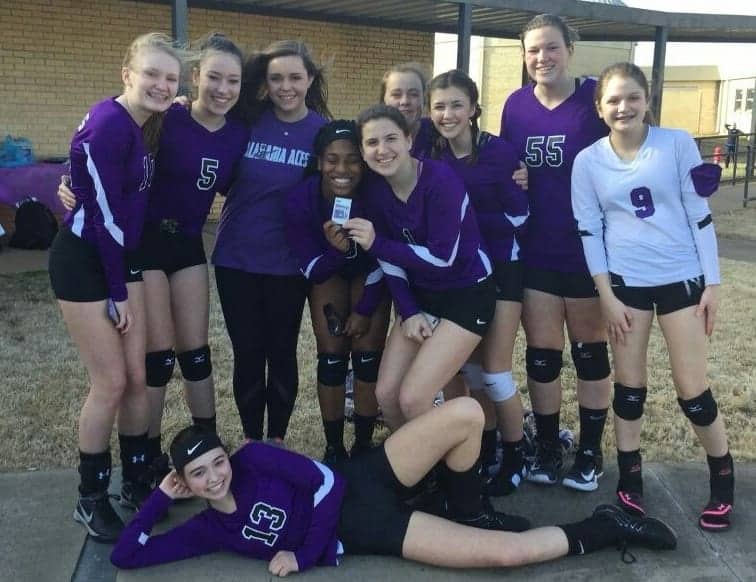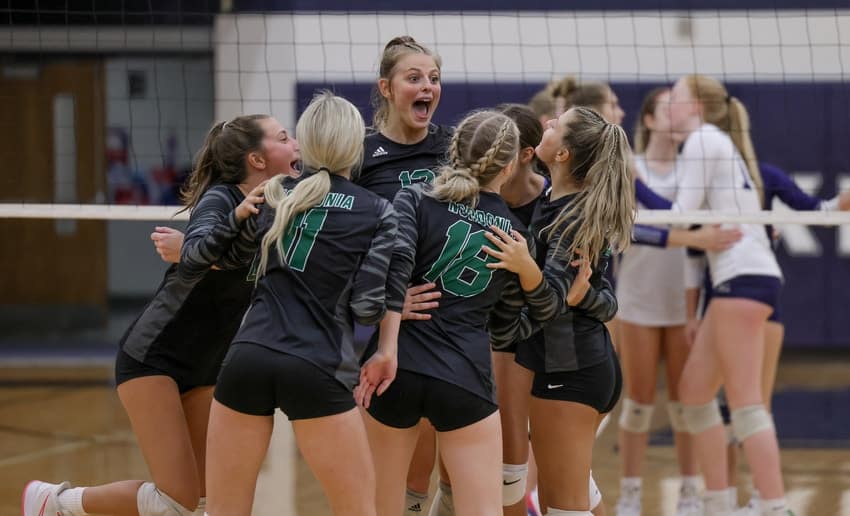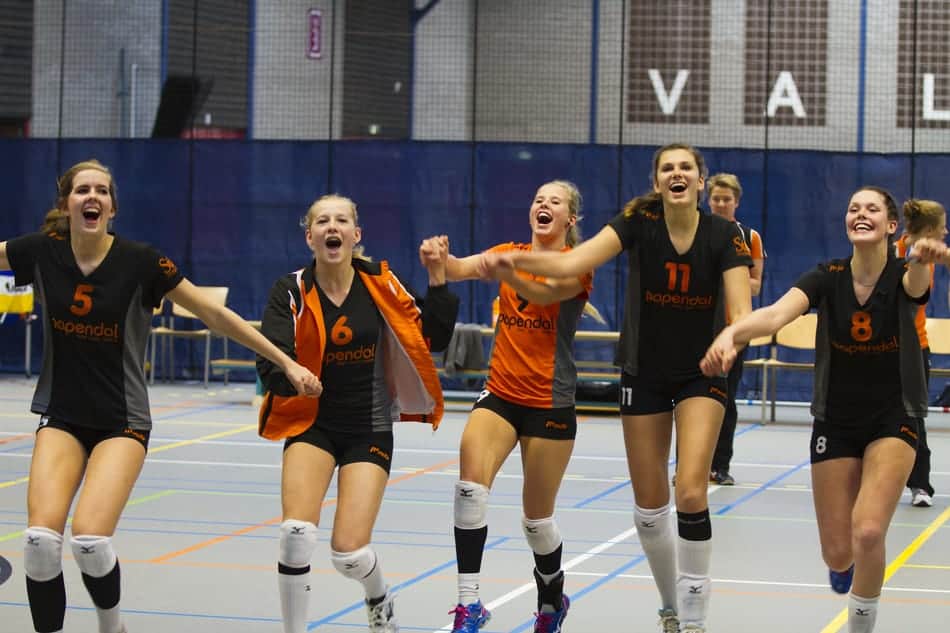If you are serious about taking your volleyball career to the next level, it won’t be long before you’re considering signing up for a club team. It’s a huge opportunity for players to grow in their school’s off-season by joining a club.
So how much does club volleyball cost, and is it worth it? The average club season will cost between $3000 and $5000 depending on many different choices and options. This is only the average clubs, not the cheapest, nor the elite.
Breaking Down the Costs
So when a player and their family start searching for a club, it’s hard to know all the questions to ask and what the consequences are to some of the choices you will make. It’s very easy to be blindsided and overwhelmed by more and more surprise costs and fees along the way.
This article will help you to anticipate many of these costs and know what to look for and ask ahead of time.
Is it time for you to start the recruiting process? If so, make sure to take a few minutes to read our Complete List of Recruiting Tips.
The Club Itself
The most obvious expense is the cost of actually joining a club. Each club has its own club dues that can really be whatever the club deems reasonable.
Many clubs will offer different levels of teams which will have a different price tag along with a different tournament schedule and possibly even a different amount of practice time.

If you happen to live in a heavily populated area and/or an area where volleyball is very popular, the benefit will be increased competition between clubs to give you the best value. In our area, there are several different clubs to choose from and they tend to keep each other in check from this competition.
The Average Clubs
Most average clubs will offer a strong list of High School coaches that are paid staff members. They typically have a dedicated practice facility and draw enough players to field several teams at each age level, which allows your player an opportunity to find a place that’s suitable to fit in. It’s common to have tryouts for your age group with 100+ players.
Some of these clubs have a set number of coaches and team slots and are only looking to fill those slots with the best players they can find. Other clubs are more inclusive and have a flexible number of teams and will simply add more teams and coaches to the lower level of the talent pool if necessary to give every player a chance to join.
Often the prices will range from $1800 for a lower level team with only 2 or 3 tournaments to $3500 for the top teams with 7-8 tournaments.
The focus in this kind of club is to offer the greatest level of coaching and competition possible at a reasonable price. These clubs also focus on helping players get recruited to college.
The Elite Clubs
Elite clubs definitely have a dedicated facility, often very elaborate and extensive. They will offer the very best coaches available, drawing from the best High School and even College level coaches in the area. They will usually have 3 levels of teams within their club: National, Regional, and Local.
To play for their National Team you will have to be a very advanced athlete, make a major time commitment, and be able to commit to the highest levels of dues. These players will usually be paying between $4000 and $6000 for the season.
Keep in mind that’s just the price tag to be on the team. These teams will usually average 10 tournaments. These tournaments may be anywhere in the country and may require flying and other major expenses.
If you join a Regional Team they will often schedule 7 or 8 tournaments, and the dues will usually reflect that. Because these tournaments will not be as large and prestigious, the cost per tournament should be a little lower.
Playing for a Local Team in one of these elite clubs is still quite a commitment. They will typically have 5 or 6 tournaments within a closer geographic footprint. The benefit here is that you are still exposed to some fantastic coaching and part of an organization that is built to win.
All the teams within the club may actually play at some of the same tournaments (especially if they have a large regional tournament nearby), or they may not overlap at all. It really depends on the tournaments available and the goals of the club director.
The focus in this kind of club is to be the best, to take on the best teams around the country and to rank nationally. Players in these clubs will have great exposure to be recruited for the next level.
“Not-For-Profit” Clubs
There are some clubs that have begun from parents and coaches being frustrated with the immense costs of the typical clubs. These are run by volunteers and usually operate on a very low profit or non-existent profit margin to make the club season available to players who would otherwise never be able to afford it.
These clubs don’t own their own facilities, so they may operate out of a school gym, a church building or a community center. Some of these clubs arrange to “borrow” courts from the YMCA or other privately owned gyms.
The coaches for these clubs are usually volunteering and only their expenses may be paid. Sometimes they will be coaching in exchange for their own child or children to be allowed to play on the club’s teams for free.

In these clubs, enrollment can be unpredictable. You may have to “play up” to the next age group if there aren’t enough players at your age. Some of these will have many more teams at the lower age groups because as players age and become more serious, they will tend to find their way to the higher clubs.
You can expect to pay at least $600 and possibly up to $1500 for your dues. Almost all the dues go to cover tournament fees, uniforms, and equipment for practices.
Expect a great majority of the tournaments to be local so that travel is kept to a minimum. Some of these clubs may offer just as many tournaments as the elite teams in the highest level clubs, but they may be playing in a local High School gym instead of their team flying into Thousand Oaks, CA for the weekend.
The focus in this kind of club is on the players getting the best experience they can without breaking the bank.
So within each of these clubs, there will be variations in the fees. Ask questions before and during the tryout process. Some clubs have everything laid out clearly on their website, but many clubs don’t communicate clearly to parents. Just keep asking questions until you understand all the variables.
Hidden Fees
Besides the actual dues, there are a lot of “hidden” fees throughout the club season.
Tryout Fees
The very first fees you will pay are to try out. It’s usually wise to try out for several clubs so that you can learn their differences and make an informed choice.
Even if you think you know which club you will play for, it’s good to try out for at least a second option in case you aren’t chosen for the team you anticipate. It’s also a good experience to go through multiple tryouts to expand your experience as a player.
Expect to pay $25-$75 per club that you try out with.
Registering With Your State Athletic Association
Like many sports, volleyball differs greatly from state to state. Each region has its own athletic associations and you will likely be required to register either before trying out for a club or before committing to one. This governing body tracks players throughout the season to maintain that clubs and teams are following the rules.
Expect to pay $15-$50 per year.
Admission Fees
It may surprise you that after everything you’ve invested to get this far when you arrive at your first tournament, you’ll still have to pay to get in. Tournament admission fees are charged to everyone who is not a player or a coach.
Many multi-day tournaments offer a reduced rate if you will pay for admission for the whole tournament upfront. They will usually give you a wristband that you should keep on for the weekend. Children may be charged a reduced fee, but that’s not necessarily true at every tournament.
Expect to pay $8/day/person on average.
Parking
Usually, your smaller local tournaments will not charge for parking. Plan on having to pay some parking anytime you’re tournament venue is in any building that is not a High School.
Expect a wide range, $5 to $20 per vehicle.
Tournament Apparel
While this is certainly optional, you will want to have a keepsake or souvenir once in a while from some of these tournaments. Some will have very unique and nifty T-shirts.
Players really enjoy wearing these during their school season to let their friends and teammates see that they’re a well-traveled player. Most players don’t buy tournament apparel from every tournament they attend, but most will buy some at some point during the season.
I recommend looking for that unique shirt or hoodie that’s got a memorable slogan and plan to buy 1 or 2 throughout your travels.
Tournament Travel
There are many factors that will affect just how expensive your club travel will be. Will you be traveling as a family or just one player, one parent?
Are your tournaments within driving distance or will you have to stay in a hotel? If you’re staying in a hotel, will you be staying with everyone from the club at a specific hotel or is everyone on their own to find the best deals they can?
Is it a one-day tournament or two? Often those one-day tournaments stretch into marathons, and maybe you need to get a room for the night spontaneously since the tournament ran so late?
You will have to account for food, which will include meals on the road, snack food and drinks for the team during the tournament, and trips to the concession stands. If you’re staying in a hotel, the breakfast buffet option becomes very valuable on tournament trips.
You may also consider sightseeing. After all, you may be traveling to places you’ve never been to before.
You and your family may want to remember something about this place other than the inside of a gym! Consider and plan for this possibility when your club releases its tournament schedule at the beginning of the season.

Would you like to shop for the elbow pads that we recommend? Click here or on the button below.
How To Determine If Playing “Club” Is Worth The Cost
Well the answer, like so many things in life, is still “it depends.” It’s not a simple mathematical calculation. Some expect that if they spend for example $4000 per year playing club they can count on a full scholarship in college which would more than compensate the expense.
The problem, of course, is what if the player gets tired of the sport and wants to quit before college? What if they fall behind or simply aren’t good enough? What about the risk of injury?
What about life situations and family events that could interfere? What if you had to move to a new location or school partway through a year and missed a season? What if the player decides after all, that they don’t even want to go to college? So many things could derail this plan.
Each parent and family really have to assess their situation each season and consider where they are. Here are a few questions to help guide you to finding your decision:
- How important is volleyball to the player?
- Is this their only sport? Is this their main hobby?
- Do they have a true passion for volleyball?
- Is the player good enough that they could choose to pass the club season and be certain to make the school team anyway?
- Are they generally athletic and have a high overall fitness level?
- When you consider their place on the team, how do they rank at their particular position?
- Is money an issue? This may mean your club choices are limited. This may mean you choose one of the lower-tier teams at your club even if you’re offered a higher team after tryouts.
- Is the time commitment for the family reasonable?
- The seasons run from one to another and wear your family down. Does your family need a break?
- Are there other members of the family in other clubs, teams, sports, and programs?
Hopefully, after reading through these questions, you can see the right path for your player. Remember to just take one season at a time. What may be the right thing for you this season may not be the right thing next year.
If you decide to skip the club season but plan to play in the future, read through our article: How You Can Get Better At Volleyball By Yourself to keep yourself competitive next year.
Related Questions
How Do I Know If I Made the Club Team?
So after you try out for a club, they have a small window of time to offer you a position on a team. They will want an answer from you as soon as possible.
You have every right to take up until the deadline to give them an answer. If you know for sure that you want to accept, then go ahead and accept. This helps them lock up the best players and know who they can count on.
If you are waiting to hear from another club, simply tell the first club you haven’t decided yet and you will let them know before the deadline. You want to make the best decision for yourself, so don’t let them pressure you into committing when you’re not ready.
Teams simply go down the list and offer the next best players for the slots that they have. You may be offered to play for their second team and then get moved up to their first team because someone else chose a different club.
If you’ve never tried out before, take a moment to read about my daughter Heidie’s experiences in What Are Volleyball Tryouts Really Like?
Why Is My Team Scheduled to Play a Younger Team in This Tournament?
Sometimes teams will “play up” in a tournament to test themselves. If they’ve been successful in the past, they may want the competition of playing against older teams. This is especially common with Power teams as they’re looking to constantly push their players to the next level.
Photo Credits:
Feature image by Dan Morgan on flickr.com: https://creativecommons.org/licenses/by/2.0/
Black & Green team image by K.M. Klemencic on flickr.com: https://creativecommons.org/publicdomain/mark/1.0/
Black and orange team photo by wang hah on flickr.com: https://creativecommons.org/licenses/by/2.0/
Recent Posts
Athletes, listen up! Do you have a closet full of old jerseys, sweatpants, and tees that you just can't seem to part with? Well, dust them off, because you're sitting on a goldmine of fashion...
You may have heard, or you may have noticed, that there's been a change to the rule about double contact in volleyball. In 2022, an experimental rule change began to be implemented, where the double...
